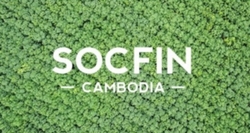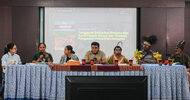Socfin Cambodia | 18 Oct 2019
POSITION STATEMENT
Recently some articles have been released in the French and Cambodian press regarding a procedure contesting our responsible management and Bolloré’s alleged liability in our activities in Cambodia (1-10-2019).
On 22 and 25 July 2016, 51 Cambodian citizens of the Bunong community of Mondulkiri province sued two subsidiaries of the Bolloré group before the French court in Nanterre for stealing their land. They are also criticized for "failing to comply with their obligation to conduct business reasonably".
On 15 March 2018 the same persons, subsequently joined by 29 other members of the same community, sued into the pending proceedings a subsidiary of the Socfin group, the Belgian company Socfinco.
To date, after 4 years of proceedings, the Tribunal has not yet examined the merits of the case. Indeed, the plaintiffs did not produce any document to justify their grievances, or even their precise identity.
The debates were therefore limited to cross-references for the disclosure of documents.
The Tribunal postponed the proceedings to 8th November 2019 to rule exclusively on the respective requests for the production of documents.
Transparency
Socfin Cambodia believes that responsible management and strong stakeholder partnerships create value and contribute to sustainable development. As we work to create value across all of our developments, attention to environmental and social performance within the value chain is a key core value of the company.
Socfin Cambodia is proudly committed to the sustainable development and management of its rubber estates and equally committed to the communities where it maintains operations as stated in its publicly available Zero Deforestation Commitment. (1)
To fulfil its commitment of transparency, Socfin Cambodia reports yearly on its local activities through the publication of its Sustainability Report. For more information, the 2018 edition is available online (2).
Prior to the project
Socfin in Cambodia (Socfin Cambodia) is present through two Cambodian companies: Socfin-KCD and Coviphama both managing rubber plantations in Mondulkiri Province. Socfin-KCD was created in 2007 and is operating through two Economic Land Concessions (ELCs) and Coviphama was acquired in 2013.
Before starting its operations, the company carefully evaluated different potential concessions. Several were refused based on study findings that indicated social or environmental impacts outside permissible parameters, and not consistent with the company’s values. The concessions managed today by Socfin-KCD were approved by the government in 2009 and 2010. The concession of Coviphama was approved in 2008, prior to its acquisition. No work started on these concessions until all government requirements were fulfilled and completed, including conducting Initial Environmental and Social Impact Assessments (IESIA) -registered with the Ministry of Environment -which guided the development activities.
Compensation process and communal land preservation
During both the assessment phase and at the beginning of each activity on the concessions, the company has always maintained regular and ongoing dialogue with the local population. This was done through numerous open public meetings attended by independent observers such as the local office of the United Nations. An in-house department called the Bunong Administration composed of employees from the local communities was created to facilitate all communication and is still existing today.
Between 2009 and 2012, comprehensive compensation options were presented to the affected population. Although initial assessments for Socfin-KCD showed that cultivated and fallow fields covered only 1 193 hectares, the company compensated a total of 1 348 hectares. To ensure families had confidence in the process and its outcome, the compensation program was conducted in the local language by the Bunong Administration. At the end of 2012, all cases were amicably resolved together with 816 accepted claimant families. Communal areas including spirit forests, sacred forests and cemeteries were identified, mapped and preserved by the company together with local representatives of the indigenous community.
⇨ In 2012 an agreement was signed with the local communities to attest that all existing sacred land had been preserved and that there was no conflict related to this type of land. To the company’s knowledge, these are the only sacred areas which are officially mapped and marked in the area.
The entire process has been documented and shared with all parties involved.
As a result of this phase of studies and consultations, Socfin-KCD and Coviphama removed vast areas from their business land including: over 3 000 hectares of environmental areas, 500 hectares of community areas for traditional farming and over 350 hectares of communal land (including cemeteries, sacred forests, spirit forests and reserve land). In addition, individual fields used for farming inside the concessions have today received individual land titles covering a total of 730 hectares including overlapping land with traditional community areas.
⇨ In 2015, after more than two years with no new land claims, new requests were presented to the company.
These demands were born in a context of high land speculation in the area. Until then, Mondulkiri was the least densely populated region in the country but has been quickly opening-up in the span of a few years, as a result of the national public development plan.
Existing communication mechanisms in the context of new claims
In response to the new requests presented, Socfin Cambodia reactivated a platform of dialogue, the Tripartite Committee, which consists of the local authorities, elected representatives of the indigenous population, and representatives of the company. Socfin Cambodia works in full transparency with the United Nations O.H.C.H.R (the Office of the High Commissioner for Human Rights) in Phnom Penh, which is consulted, informed of each meeting and receives all meeting minutes.
⇨ This committee is still active today and is used to exchange information on Socfin Cambodia’s activities with the communities and to discuss common development projects.
Based on the example of the Tripartite Committee, the OHCHR set up multi-stakeholders meetings to enhance dialogue and cooperation between all local stakeholders (local communities, private companies, NGOs):
⇨ Aimed at addressing the issues existing in the whole Commune of Bousra.
⇨ It met 3 times in 2015 and 2016 (all local stakeholders active in the whole of Bousra Commune are invited by the elected representatives of the population).
In order to ensure a fair resolution of the land claims for all, together with the local population, th company called for the support of an independent organization with expertise in land mapping, GIZ (German International Cooperation) which undertook the mapping activities of claimed land in 2016-2017. Based on this first mapping process, the company and the communities are today engaged in a mediation process conducted by IMG (Independent Mediation Group):
⇨ Observers to the process include the local authorities and organizations such as MRLG (Mekong Region Land Governance) and the UN O.H.C.H.R (3) in Cambodia.
⇨ At the request of the communities, observers and advisors, discussions are confidential at the moment and no information may be shared until final agreements are reached.
⇨ This process is a pilot project for Cambodia and is voluntary and based on trust.
Legal situation
By tradition, as all Cambodian indigenous population, the Bunong people tend to act and manage their land as belonging to the community, not to individuals.
Typically, the Bunong communities in Bousra Commune have traditional as well as democratically elected representatives which are officially recognized. Those elected or mandated are representative of the situation of the whole community of the Bousra Commune (6 500 inhabitants (4)) and -to our knowledge- are not involved in this legal action.
Furthermore, a few individuals have directly contacted Socfin Cambodia in 2018, addressing letters expressing their wish to withdraw from the civil action in France and join the mediation process (see below). They reportedly have not been heard by their lawyer who is currently still conducting the action in their name without their consent. Many aspects of the procedure need to be clarified like the real plaintiffs’ capacity to represent the case.
Socfin’s project in Bousra Commune is part of a development program of the Mondulkiri province, and as such is defined, guided and driven under the authority and control of the public authorities in Cambodia. Further to this point, the land where the plantations are developed belongs to the Cambodian state, Socfin-KCD and Coviphama are Cambodian companies, and individuals involved are Cambodian nationals. Thus, the appropriate legal jurisdiction to handle this case should be Cambodia.
Conclusion
Socfin Cambodia recognizes the right of communities to express their grievances and opinions through the channels of their choice. However, various communication and consultation mechanisms, detailed above, have been established directly in Bousra (Cambodia), and have been designed in consultation with external stakeholderswith a strong attention placed on being adapted to the local culture and customs. Socfin Cambodia continues to put all efforts into implementing its sustainable management policy and pursuing the peaceful dialog with communities.
1 Available online
2 https://www.socfin.com/sites/default/files/2019-09/2019%2009%2005%20SocfinCambodia-2018SustainabilityReport-Final_1.pdf
3 Point 44 of OHCHR report 02/2018: http://cambodia.ohchr.org/sites/default/files/Ohchr-report/G1802262.pdf
4 Data from Bousra Commune Office, 2016
POSITION STATEMENT
Recently some articles have been released in the French and Cambodian press regarding a procedure contesting our responsible management and Bolloré’s alleged liability in our activities in Cambodia (1-10-2019).
On 22 and 25 July 2016, 51 Cambodian citizens of the Bunong community of Mondulkiri province sued two subsidiaries of the Bolloré group before the French court in Nanterre for stealing their land. They are also criticized for "failing to comply with their obligation to conduct business reasonably".
On 15 March 2018 the same persons, subsequently joined by 29 other members of the same community, sued into the pending proceedings a subsidiary of the Socfin group, the Belgian company Socfinco.
To date, after 4 years of proceedings, the Tribunal has not yet examined the merits of the case. Indeed, the plaintiffs did not produce any document to justify their grievances, or even their precise identity.
The debates were therefore limited to cross-references for the disclosure of documents.
The Tribunal postponed the proceedings to 8th November 2019 to rule exclusively on the respective requests for the production of documents.
Transparency
Socfin Cambodia believes that responsible management and strong stakeholder partnerships create value and contribute to sustainable development. As we work to create value across all of our developments, attention to environmental and social performance within the value chain is a key core value of the company.
Socfin Cambodia is proudly committed to the sustainable development and management of its rubber estates and equally committed to the communities where it maintains operations as stated in its publicly available Zero Deforestation Commitment. (1)
To fulfil its commitment of transparency, Socfin Cambodia reports yearly on its local activities through the publication of its Sustainability Report. For more information, the 2018 edition is available online (2).
Prior to the project
Socfin in Cambodia (Socfin Cambodia) is present through two Cambodian companies: Socfin-KCD and Coviphama both managing rubber plantations in Mondulkiri Province. Socfin-KCD was created in 2007 and is operating through two Economic Land Concessions (ELCs) and Coviphama was acquired in 2013.
Before starting its operations, the company carefully evaluated different potential concessions. Several were refused based on study findings that indicated social or environmental impacts outside permissible parameters, and not consistent with the company’s values. The concessions managed today by Socfin-KCD were approved by the government in 2009 and 2010. The concession of Coviphama was approved in 2008, prior to its acquisition. No work started on these concessions until all government requirements were fulfilled and completed, including conducting Initial Environmental and Social Impact Assessments (IESIA) -registered with the Ministry of Environment -which guided the development activities.
Compensation process and communal land preservation
During both the assessment phase and at the beginning of each activity on the concessions, the company has always maintained regular and ongoing dialogue with the local population. This was done through numerous open public meetings attended by independent observers such as the local office of the United Nations. An in-house department called the Bunong Administration composed of employees from the local communities was created to facilitate all communication and is still existing today.
Between 2009 and 2012, comprehensive compensation options were presented to the affected population. Although initial assessments for Socfin-KCD showed that cultivated and fallow fields covered only 1 193 hectares, the company compensated a total of 1 348 hectares. To ensure families had confidence in the process and its outcome, the compensation program was conducted in the local language by the Bunong Administration. At the end of 2012, all cases were amicably resolved together with 816 accepted claimant families. Communal areas including spirit forests, sacred forests and cemeteries were identified, mapped and preserved by the company together with local representatives of the indigenous community.
⇨ In 2012 an agreement was signed with the local communities to attest that all existing sacred land had been preserved and that there was no conflict related to this type of land. To the company’s knowledge, these are the only sacred areas which are officially mapped and marked in the area.
The entire process has been documented and shared with all parties involved.
As a result of this phase of studies and consultations, Socfin-KCD and Coviphama removed vast areas from their business land including: over 3 000 hectares of environmental areas, 500 hectares of community areas for traditional farming and over 350 hectares of communal land (including cemeteries, sacred forests, spirit forests and reserve land). In addition, individual fields used for farming inside the concessions have today received individual land titles covering a total of 730 hectares including overlapping land with traditional community areas.
⇨ In 2015, after more than two years with no new land claims, new requests were presented to the company.
These demands were born in a context of high land speculation in the area. Until then, Mondulkiri was the least densely populated region in the country but has been quickly opening-up in the span of a few years, as a result of the national public development plan.
Existing communication mechanisms in the context of new claims
In response to the new requests presented, Socfin Cambodia reactivated a platform of dialogue, the Tripartite Committee, which consists of the local authorities, elected representatives of the indigenous population, and representatives of the company. Socfin Cambodia works in full transparency with the United Nations O.H.C.H.R (the Office of the High Commissioner for Human Rights) in Phnom Penh, which is consulted, informed of each meeting and receives all meeting minutes.
⇨ This committee is still active today and is used to exchange information on Socfin Cambodia’s activities with the communities and to discuss common development projects.
Based on the example of the Tripartite Committee, the OHCHR set up multi-stakeholders meetings to enhance dialogue and cooperation between all local stakeholders (local communities, private companies, NGOs):
⇨ Aimed at addressing the issues existing in the whole Commune of Bousra.
⇨ It met 3 times in 2015 and 2016 (all local stakeholders active in the whole of Bousra Commune are invited by the elected representatives of the population).
In order to ensure a fair resolution of the land claims for all, together with the local population, th company called for the support of an independent organization with expertise in land mapping, GIZ (German International Cooperation) which undertook the mapping activities of claimed land in 2016-2017. Based on this first mapping process, the company and the communities are today engaged in a mediation process conducted by IMG (Independent Mediation Group):
⇨ Observers to the process include the local authorities and organizations such as MRLG (Mekong Region Land Governance) and the UN O.H.C.H.R (3) in Cambodia.
⇨ At the request of the communities, observers and advisors, discussions are confidential at the moment and no information may be shared until final agreements are reached.
⇨ This process is a pilot project for Cambodia and is voluntary and based on trust.
Legal situation
By tradition, as all Cambodian indigenous population, the Bunong people tend to act and manage their land as belonging to the community, not to individuals.
Typically, the Bunong communities in Bousra Commune have traditional as well as democratically elected representatives which are officially recognized. Those elected or mandated are representative of the situation of the whole community of the Bousra Commune (6 500 inhabitants (4)) and -to our knowledge- are not involved in this legal action.
Furthermore, a few individuals have directly contacted Socfin Cambodia in 2018, addressing letters expressing their wish to withdraw from the civil action in France and join the mediation process (see below). They reportedly have not been heard by their lawyer who is currently still conducting the action in their name without their consent. Many aspects of the procedure need to be clarified like the real plaintiffs’ capacity to represent the case.
Socfin’s project in Bousra Commune is part of a development program of the Mondulkiri province, and as such is defined, guided and driven under the authority and control of the public authorities in Cambodia. Further to this point, the land where the plantations are developed belongs to the Cambodian state, Socfin-KCD and Coviphama are Cambodian companies, and individuals involved are Cambodian nationals. Thus, the appropriate legal jurisdiction to handle this case should be Cambodia.
Conclusion
Socfin Cambodia recognizes the right of communities to express their grievances and opinions through the channels of their choice. However, various communication and consultation mechanisms, detailed above, have been established directly in Bousra (Cambodia), and have been designed in consultation with external stakeholderswith a strong attention placed on being adapted to the local culture and customs. Socfin Cambodia continues to put all efforts into implementing its sustainable management policy and pursuing the peaceful dialog with communities.
1 Available online
2 https://www.socfin.com/sites/default/files/2019-09/2019%2009%2005%20SocfinCambodia-2018SustainabilityReport-Final_1.pdf
3 Point 44 of OHCHR report 02/2018: http://cambodia.ohchr.org/sites/default/files/Ohchr-report/G1802262.pdf
4 Data from Bousra Commune Office, 2016













